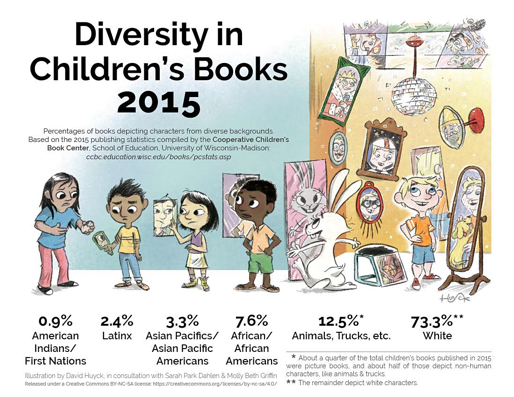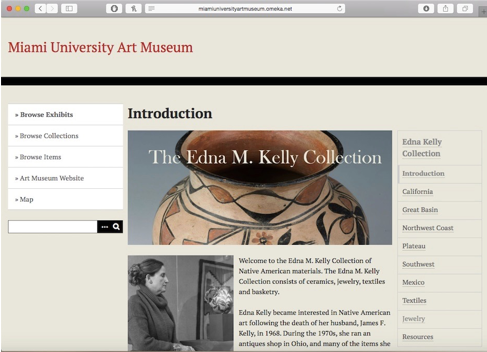By Lena Rutheford
When was the last time you read a children’s book? Do you have a childhood favorite? You might gain a new perspective on children’s literature, and particularly children’s book illustrations, at the Miami University Art Museum’s upcoming exhibition Telling a People’s Story: African American Children’s Illustrated Literature on January 30 – June 30, 2018. For curator of exhibition, Jason Shaiman, children’s literature holds a special place in his heart. Shaiman has a particular passion for Curious George, which was the impetus for this exhibition. He originally enjoyed the series growing up and his love for children’s literature inspired him to create an exhibition with it. Shaiman shares, “When I read children’s books with my child, I’m often caught by the notion of how often I just read the stories, and my child is hearing the stories. He can’t read it, but he’s hearing it and seeing the illustrations, and he’s understanding it. The story and the illustrations are inseparable because you wouldn’t have the art if it wasn’t for the story, and the imagery often presents what the text can’t because there are limited words. Illustrations can demonstrate the author’s intent.”
Telling a People’s Story was born from Shaiman’s passion for children’s literature and illustrations and has been ten years in the making. Shaiman originally came up with the idea when he was Chief Curator of Exhibitions at McKissick Museum at University of South Carolina. This museum focused on Southern culture and identity, so Shaiman wanted to combine children’s literature with the exploration of Southern identity. While his idea didn’t come to fruition at McKissick Museum, he kept the idea alive once he transitioned to Miami’s Art Museum. He chose to focus on how African American cultural and historical identity has changed over time through the lens of children’s literature because, according to the Cooperative Children’s Book Center, only 7.6% of all children’s books published in 2015 depict African American characters. The exhibition will feature over 30 African American illustrators with 130+ works of art and will include a chronological section focusing on African American history, as well as a biographical section celebrating figures such as York, a slave who went on the Lewis and Clark expedition, musicians, athletes, and more. Shaiman has made this an educational opportunity, not just a celebration, because “simply celebrating wouldn’t do justice to recognizing the contributions from African American authors over those decades” (Shaiman). Telling a People’s Story shows the intersection of African American cultural and historical identity and the evolution of children’s books.
According to Shaiman, nothing like this has ever been done before. There has never been such an extensive focus on African American children’s book illustrators in conjunction with African American identity. Shaiman affirms that books that focus on African American identity never have more than one or two chapters on children’s book illustrations. Additionally, there has never been an exhibit this extensive. While there have been exhibits featuring John Newbery, Caldecott, and Coretta Scott King award winners, those exhibits never contextualize the illustrations by African American cultural and historical identity. Additionally, according to Shaiman, those awards did a poor job of recognizing African Americans to begin with. The John Newbery award came out in 1922 to honor children’s literature authors, and the first African American to win was in 1976 (Park). The Caldecott Award came out in 1937 for illustrators, and didn’t recognize an African American until 1976 (SLJ). The Coretta Scott King Award was created solely to recognize African American authors and illustrators and was created in 1970 (Coretta Scott King Award). It took around 50 years for an African American illustrator or author to be recognized, meaning these exhibitions don’t accurately represent all that has been done by African Americans in children’s literature. This exhibit will truly be the first time that African American children’s literature is covered in depth and in the context of African American culture and history.
It’s also very special that this is occurring at Miami University’s Art Museum because of the unique opportunities for students and locals. The museum will be hosting a two-day conference in April 2018 bring together many African American illustrators, authors, and scholars. There will be a class, EDT 285, African American Children’s Art Illustration, offered to Miami students in spring semester 2018, while the exhibit is up. Miami classes in education, art, sociology, black world studies, English, and American history will be interacting with the exhibit as well. Several programs throughout the semester will give students and locals the opportunity to meet the illustrators and hear them speak or do workshops with them. The synergy between the university and the art museum provide unique opportunities for students, faculty, and locals to learn and grow together. This is yet another reason why Telling a People’s Story is a once-in-a-lifetime experience!
We look forward to seeing you at the exhibition!
References
SLJ. (2012, May 30). LeoLeo Dillon, the First African American Caldecott Winner, Dies at 79. School Library Journal. Retrieved from http://www.slj.com/2012/05/industry-news/leo-dillon-the-first-african-american-caldecott-winner-dies-at-79/#_
Park, Linda S. (2017). Newbery Trivia The Answers. Linda Sue Park. Retrieved from http://www.lindasuepark.com/fun/new_answ.html
Coretta Scott King Award. (2017, November 30). Retrieved December 04, 2017, from https://en.wikipedia.org/wiki/Coretta_Scott_King_Award
Shaiman, J. (2017, November 30). Personal Interview.










